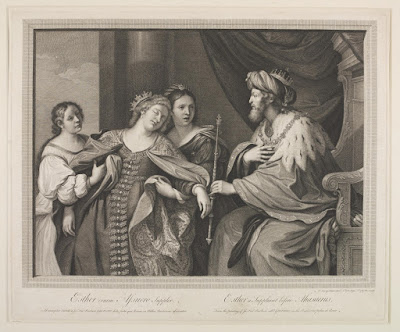 |
| Guercino (Giovanni Francesco Barbieri) God the Father Blessing ca. 1638-39 oil on canvas National Museum, Warsaw |
 |
| Guercino (Giovanni Francesco Barbieri) Holy Trinity 1638 oil on canvas Chiesa di Santa Maria della Vittoria, Rome |
"[Carlo Cesare] Malvasia included the altarpiece among Guercino's works of 1638. He refers to the patron as 'Cardinale Gessi Bolognese', that is, Cardinal Berlinghiero Gessi, and described the picture as representing 'una Santissima Trinità', destined for the Cardinal's chapel in S. Maria della Vittoria, Rome. . . . Christ's right hand extended in blessing towards the viewer casts a long shadow, in reverse, across his nude chest, merging with another shadow at the far side of his body. Was this device a deliberate reference to the work of Caravaggio, at a time when his work in Rome had become unfashionable?"
 |
| Guercino (Giovanni Francesco Barbieri) Holy Trinity 1638 drawing (compositional study) Nationalmuseum, Stockholm |
 |
| Guercino (Giovanni Francesco Barbieri) Cimmerian Sibyl 1638-39 oil on canvas (trial version) Nationalmuseum, Stockholm |
 |
| Guercino (Giovanni Francesco Barbieri) Cimmerian Sibyl 1638-39 drawing (compositional study) Metropolitan Museum of Art, New York |
 |
| Guercino (Giovanni Francesco Barbieri) Cimmerian Sibyl 1638-39 oil on canvas (finished version) Credito Emiliano, Reggio Emilia |
"Malvasia recorded the commission [for the Cimmerian Sibyl] under 1639, identifying the patron as Ludovico Ratta. A member of a noble Bolognese family, Conte Monsignore Ratta, along with his brother Giuseppe Carlo Ratta Garganelli, assembled for the Palazzo Ratta, Bologna, one of the largest and most important picture collections in 17th-century Emilia. . . . Ratta commissioned Guercino's Cimmerian Sibyl as a companion to a work already in his collection, Domenichino's Cumaean Sibyl . . . one of four autograph versions [version of the Domenichino reproduced below is similar but not identical to Ratta's]. The juxtaposition of two depictions of sibyls would have provided a talking point for well-informed connoisseurs and collectors of the day to single out the respective merits and defects of works by different artists and styles paired in this way."
 |
| Domenichino Cumaean Sibyl ca. 1622 oil on canvas Pinacoteca Capitolina, Rome |
 |
| Guercino (Giovanni Francesco Barbieri) Esther before Ahasuerus 1638-39 oil on canvas University of Michigan Museum of Art, Ann Arbor |
 |
| Guercino (Giovanni Francesco Barbieri) Esther before Ahasuerus (detail) 1638-39 oil on canvas University of Michigan Museum of Art, Ann Arbor |
Esther before Ahasuerus was commissioned by Cardinal Lorenzo Magalotti, Archbishop of Ferrara as a gift for Cardinal Antonio Barberini, who in turn presented the painting to his brother Pope Urban VIII. It remained at Palazzo Barberini in Rome until its sale by the family in the early 19th century.
 |
| Guercino (Giovanni Francesco Barbieri) Esther before Ahasuerus 1638-39 drawing (compositional study) Royal Library, Windsor |
 |
| Guercino (Giovanni Francesco Barbieri) Esther before Ahasuerus 1638-39 drawing (compositional study) private collection |
 |
| Guercino (Giovanni Francesco Barbieri) Esther before Ahasuerus 1638-39 drawing (compositional study) private collection |
 |
| Guercino (Giovanni Francesco Barbieri) Esther before Ahasuerus 1638-39 drawing (compositional study) University of Michigan Museum of Art, Ann Arbor |
 |
| Guercino (Giovanni Francesco Barbieri) Esther before Ahasuerus 1638-39 drawing (figure studies - Ahasuerus) National Gallery of Victoria, Melbourne |
 |
| Robert Strange after Guercino Esther before Ahasuerus 1767 etching and engraving Victoria & Albert Museum, London |
– quoted texts from The Paintings of Guercino: a revised and expanded catalogue raisonné by Nicholas Turner (Rome: Ugo Bozzi Editore, 2017)